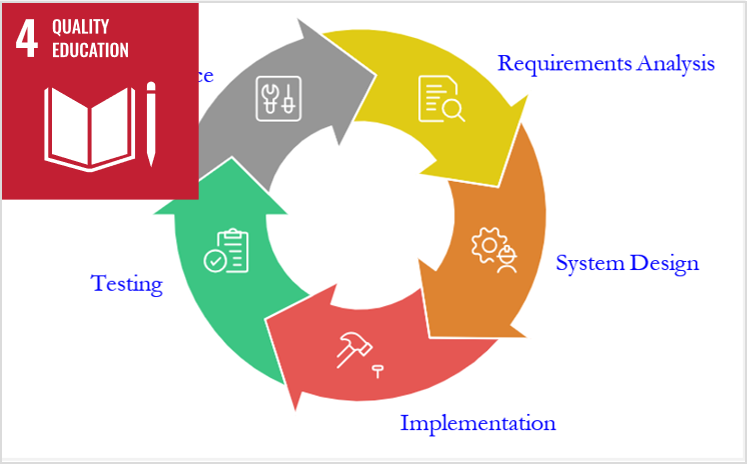Abstrak
Manual attendance systems in educational institutions, particularly in highly disciplined environments such as vocational schools with cadet programs, present significant challenges, including inaccuracy, administrative burden, and susceptibility to fraud. This study addresses these issues by designing and developing a secure mobile attendance application for the Android platform. The development process followed the Waterfall software development model, providing a structured framework from requirements analysis through testing. The proposed solution incorporates a dual-validation mechanism combining Quick Response (QR) Codes for session-specific identification with Geolocation technology to verify users’ physical presence within the designated school area. The application supports multiple user roles, including students, teachers, administrators, and parents, and offers automated attendance tracking for daily roll calls and extracurricular activities. It enables teachers to input attendance for in-class sessions manually. Empirical evaluation confirmed that the application effectively mitigates vulnerabilities inherent in the manual system. The dual-validation approach substantially enhances both the integrity and efficiency of the attendance process, offering a reliable and secure tool for monitoring student discipline. This study provides a practical model for integrating accessible digital technologies to strengthen administrative processes in secondary education contexts.
Referensi
[1] A. R. B. Putra and D. Nora, “Faktor Penghambat dalam Mengatasi Ketidakhadiran Siswa Kelas XI IPS di SMAN 1 Lubuk Basung,” Jurnal Sikola: Jurnal Kajian Pendidikan dan Pembelajaran, vol. 1, no. 4, pp. 253–264, Jul. 2020, doi: https://doi.org/10.24036/sikola.v1i4.45.
[2] M. Alda, M. Juarsyah, A. Nugraha, L. R. Alfachry, and A. K. Kerja, “Jurnal Manajemen Informatika (JAMIKA) Aplikasi Absensi Mahasiswa Kerja Praktik Menggunakan QR Code Berbasis Android,” Jurnal Manajemen Informatika, vol. 14, 2024, doi: https://doi.org/10.34010/jamika.v14i1.11775
[3] R. Firdaus, E. Wahyuni, and A. Agussalim, “Rancang Bangun Sistem Presensi Pegawai Berbasis Geo Lokasi dan Pengenalan Wajah Menggunakan Facenet,” Jurnal Media Infotama, vol. 20, no. 2, pp. 410–416, 2024, doi: https://doi.org/10.37676/jmi.v20i2.6219
[4] Y. W. S. Putra, “Implementasi Model TAM pada Sistem Informasi Presensi Online Menggunakan Face Recognition dan GPS,” JACOST, vol. 4, no. 2, Dec. 2023, doi: https://doi.org/10.52158/jacost.v4i2.577.
[5] A. Mishra and Y. I. Alzoubi, “Structured software development versus agile software development: a comparative analysis,” Int. J. Syst. Assur. Eng. Manag., vol. 14, pp. 1504–1522, 2023, doi: https://doi.org/10.1007/s13198-023-01958-5.
[6] K. Petersen, C. Wohlin, and D. Baca, “The Waterfall Model in Large-Scale Development,” in Product-Focused Software Process Improvement, F. Bomarius, M. Oivo, P. Jaring, and P. Abrahamsson, Eds. Berlin, Heidelberg: Springer, 2009, vol. 32, Lecture Notes in Business Information Processing, pp. 311–324, doi: https://doi.org/10.1007/978-3-642-02152-7_29.
[7] M. F. A. Mohamad Noor, A. F. Ibrahim, and M. N. F. Jamaluddin, “Development of Employee Attendance Management System using Flutter,” Journal of Computing Research and Innovation, vol. 8, no. 2, pp. 178–188, 2023, doi: https://doi.org/10.24191/jcrinn.v8i2.369.
[8] A. Saravanos and M. X. Curinga, “Simulating the Software Development Lifecycle: The Waterfall Model,” Appl. Syst. Innov., vol. 6, no. 6, p. 108, 2023, doi: https://doi.org/10.3390/asi6060108.
[9] D. Ly, M. Overeem, S. Brinkkemper, and F. Dalpiaz, “The Power of Words in Agile vs. Waterfall Development: Written Communication in Hybrid Software Teams,” J. Syst. Softw., vol. 219, Jan. 2025, Art. no. 112243, doi: https://doi.org/10.1016/j.jss.2024.112243.
[10] A. Bates, R. Vavricka, S. Carleton, R. Shao, and C. Pan, “Unified modeling language code generation from diagram images using multimodal large language models,” Mach. Learn. Appl., vol. 20, Jun. 2025, Art. no. 100660, doi: https://doi.org/10.1016/j.mlwa.2025.100660.
[11] S. A. Kinari, N. Funabiki, S. T. Aung, and H. H. S. Kyaw, “A Guided Self-Study Platform of Integrating Documentation, Code, Visual Output, and Exercise for Flutter Cross-Platform Mobile Programming,” Computers, vol. 14, no. 10, p. 417, 2025, doi: https://doi.org/10.3390/computers14100417.
[12] S. A. Kinari, N. Funabiki, S. T. Aung, K. H. Wai, M. Mentari, and P. Puspitaningayu, “An Independent Learning System for Flutter Cross-Platform Mobile Programming with Code Modification Problems,” Information, vol. 15, no. 10, p. 614, 2024, doi: https://doi.org/10.3390/info15100614.
[13] Supriyono, “Software Testing with the approach of Blackbox Testing on the Academic Information System,” Int. J. Innov. Sci. Technol., vol. 3, no. 2, 2020, doi: https://doi.org/10.30645/ijistech.v3i2.54.
[14] S. Baul, J. Ahamed, M. A. Islam, M. K. A. Mazumder, T. Sultan, and D. Nandi, “A comprehensive study to assist decision-makers in determining software design between four UML diagrams,” in Proc. 3rd Int. Conf. Comput. Advancements (ICCA '24), 2024, pp. 232–238, doi: https://doi.org/10.1145/3723178.3723209.
[15] J. Skalka and M. Drlík, “Development of Automatic Source Code Evaluation Tests Using Grey-Box Methods: A Programming Education Case Study,” IEEE Access, vol. 11, pp. 106772–106792, 20 Sep. 2023, doi: https://doi.org/10.1109/ACCESS.2023.3317694.
[16] L. O’Neill, H. H. Lauridsen, L. Østengaard, and A. Qvortrup, “Validity evidence for the Experiences of Teaching and Learning Questionnaire (ETLQ) in evaluations of quality learning: A systematic critical literature review,” Stud. Educ. Eval., vol. 78, Sep. 2023, Art. no. 101283, doi: https://doi.org/10.1016/j.stueduc.2023.101283.
[17] S. J. Wafudu, Y. B. Kamin, and D. Marcel, “Validity and reliability of a questionnaire developed to explore quality assurance components for teaching and learning in vocational and technical education,” Humanit. Soc. Sci. Commun., vol. 9, p. 303, 2022, doi: https://doi.org/10.1057/s41599-022-01306-1.

Artikel ini berlisensi Creative Commons Attribution 4.0 International License.
Hak Cipta (c) 2025 Hasbi Kurnia, Geovanne Farell, Denny Kurniadi, Rizkayeni Marta






 Abstract viewed: 24 times
Abstract viewed: 24 times